No routes matched location in React Router [Solved]
Last updated: Apr 7, 2024
Reading time·5 min

# No routes matched location in React Router [Solved]
The React Router warning "No routes matched location" is shown for multiple reasons:
- trying to access a route for which a
<Route />component with the given path hasn't been set. - using multiple
Routescomponents. - forgetting to specify a wildcard matcher for a subpath, e.g.
/users/*to match descendent routes. - using multiple layouts incorrectly (e.g. anonymous/authenticated).

# Forgetting to set up a Route for a specific path
Here is an example of how the warning is raised.
import React from 'react'; import { BrowserRouter as Router, Route, Link, Routes, } from 'react-router-dom'; export default function App() { return ( <Router> <div> <nav> <ul> <li> <Link to="/">Home</Link> </li> <li> <Link to="/about">About</Link> </li> </ul> </nav> <Routes> <Route path="/about" element={<About />} /> <Route path="/" element={<Home />} /> </Routes> </div> </Router> ); } function Home() { return <h2>Home</h2>; } function About() { return <h2>About</h2>; }
The App component above has Route components for the paths:
/about> renders the<About />component/> renders the<Home />component
However, if I try to navigate to /contacts in my browser, I get the following
warning:
- No routes matched location "/contacts"
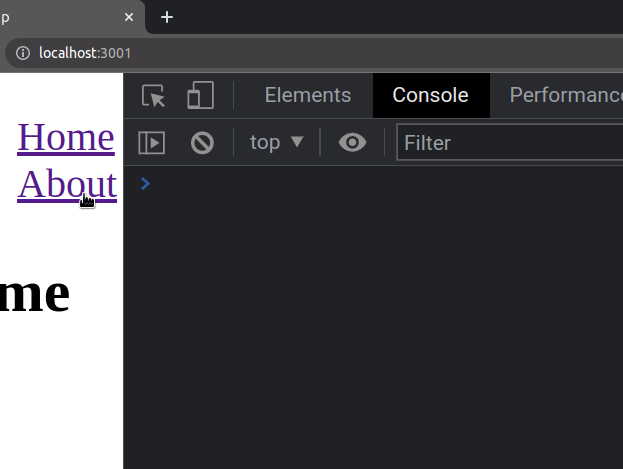
This is caused because there is no Route component that matches the
/contacts path.
One way to get around this is to set up a <Route /> that matches the specified
in the warning message path.
import React from 'react'; import { BrowserRouter as Router, Route, Link, Routes, } from 'react-router-dom'; export default function App() { return ( <Router> <div> <nav> <ul> <li> <Link to="/">Home</Link> </li> <li> <Link to="/about">About</Link> </li> <li> <Link to="/contacts">Contacts</Link> </li> </ul> </nav> <Routes> <Route path="/about" element={<About />} /> <Route path="/contacts" element={<Contacts />} /> <Route path="/" element={<Home />} /> </Routes> </div> </Router> ); } function Home() { return <h2>Home</h2>; } function About() { return <h2>About</h2>; } function Contacts() { return <h2>Contacts</h2>; }
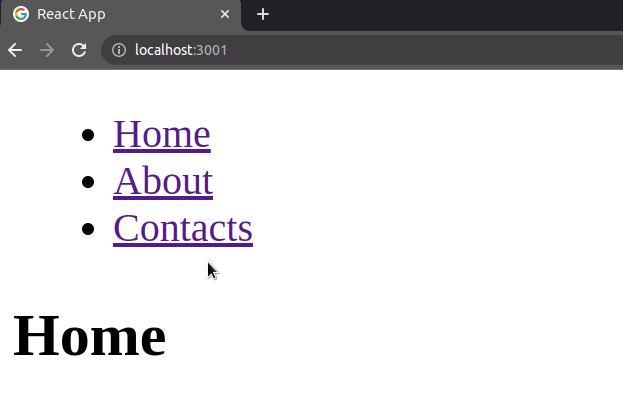
We added a /contacts Route, so when the user tries to navigate to the
/contacts page, the <Contacts /> component is rendered.
<Route path="/contacts" element={<Contacts />} />
# Creating a Route that matches all unmatched paths
However, in some cases, you might want to create a <Route /> that
matches all unmatched paths.
In this case, you can use a wildcard match * character.
import React from 'react'; import { BrowserRouter as Router, Route, Link, Routes, } from 'react-router-dom'; export default function App() { return ( <Router> <div> <nav> <ul> <li> <Link to="/">Home</Link> </li> <li> <Link to="/about">About</Link> </li> <li> <Link to="/contacts">Contacts</Link> </li> </ul> </nav> <Routes> <Route path="/about" element={<About />} /> <Route path="/" element={<Home />} /> {/* 👇️ MUST BE SPECIFIED LAST IN THE LIST OF ROUTE components 👇️ */} <Route path="*" element={<MatchAllRoute />} /> </Routes> </div> </Router> ); } function Home() { return <h2>Home</h2>; } function About() { return <h2>About</h2>; } function MatchAllRoute() { return <h2>The requested page does not exist</h2>; }
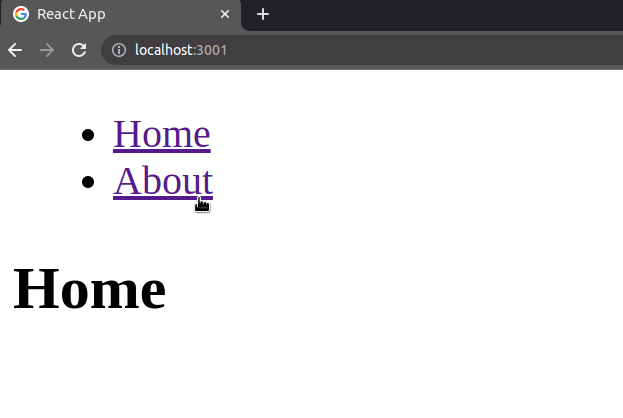
Note that the route that matches all unmatched <Route /> components paths has
to be placed last.
<Routes> <Route path="/about" element={<About />} /> <Route path="/" element={<Home />} /> {/* 👇️ MUST BE SPECIFIED LAST IN THE LIST OF ROUTE components 👇️ */} <Route path="*" element={<MatchAllRoute />} /> </Routes>
Now when the user tries to access any path that is not /about or /, the
<MatchAllRoute /> component is rendered.
# Creating a Route that matches all subpaths of a path
The "No routes matched location" warning is also shown when you haven't created
a <Route /> that matches all subpaths of a path.
For example, suppose that you have a /users route but need to create a route
that matches /users/1, /users/2, or /users/N.
In this case, you have to use a wildcard matcher for the subpath.
import React from 'react'; import { BrowserRouter as Router, Route, Link, Routes, } from 'react-router-dom'; export default function App() { return ( <Router> <div> <nav> <ul> <li> <Link to="/">Home</Link> </li> <li> <Link to="/about">About</Link> </li> <li> <Link to="/users">Users</Link> </li> <li> <Link to="/users/123">User 123</Link> </li> <li> <Link to="/users/456">Users 456</Link> </li> </ul> </nav> <Routes> <Route path="/about" element={<About />} /> <Route path="/" element={<Home />} /> <Route path="/users" element={<Users />} /> {/* Use a route that matches all /users/ subpaths */} <Route path="/users/*" element={<UserDetails />} /> </Routes> </div> </Router> ); } function Home() { return <h2>Home</h2>; } function About() { return <h2>About</h2>; } function Users() { return <h2>Users</h2>; } function UserDetails() { return <h2>User Details</h2>; }

The following <Route /> matches /users/123, /users/456, /users/abc, etc.
<Route path="/users/*" element={<UserDetails />} />
Any subpath of /users is matched by the <Route /> and the <UserDetails />
component is rendered.
This is useful when you need to dynamically render a link to a detailed page and don't necessarily know the complete path ahead of time.
# Navigating to a different route when a certain path is requested
In some cases, you might want to navigate to a different route if a certain path is requested.
Here is an example.
import React from 'react'; import { BrowserRouter as Router, Route, Link, Routes, Navigate, } from 'react-router-dom'; export default function App() { return ( <Router> <div> <nav> <ul> <li> <Link to="/">Home</Link> </li> <li> <Link to="/about">About</Link> </li> <li> <Link to="/users">Users</Link> </li> </ul> </nav> <Routes> <Route path="/about/*" element={<About />} /> <Route path="/users/*" element={<Users />} /> <Route path="/" element={<Navigate to="/about" />} /> </Routes> </div> </Router> ); } function About() { return <h2>About</h2>; } function Users() { return <h2>Users</h2>; }
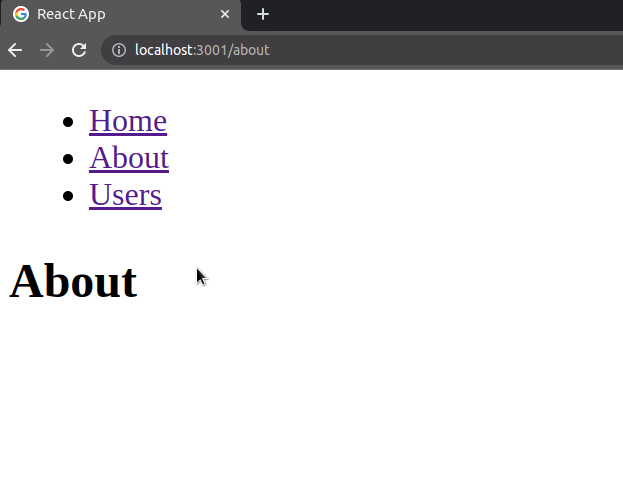
When the user requests /about or /about/123, then the <About /> component
is rendered.
<Routes> <Route path="/about/*" element={<About />} /> <Route path="/users/*" element={<Users />} /> <Route path="/" element={<Navigate to="/about" />} /> </Routes>
Similarly, when they request /users or /users/123, then the <Users />
component is rendered.
We also want to render the <About /> component when the user goes to /, so
we used the <Navigate /> component to render the /about route when the user
goes to /.
You don't necessarily have to match the subpaths with an asterisk if your use case doesn't require it.
# Using multiple layouts in React Router
In some cases, you might need to use multiple layouts in a React Router application, e.g. anonymous/authenticated.
Here is a short example.
import React from 'react'; import { BrowserRouter as Router, Route, Link, Routes, Outlet, } from 'react-router-dom'; export default function App() { return ( <Router> <div> <nav> <ul> <li> <Link to="/">Home</Link> </li> <li> <Link to="/login">Login</Link> </li> </ul> </nav> <AppRoute /> </div> </Router> ); } function Login() { return <h2>Login Page</h2>; } function AnonymousLayout() { return ( <div> <h1>Anonymous Users Page</h1> <Outlet /> </div> ); } const AppRoute = () => { return ( <Routes> <Route path="/" element={<AnonymousLayout />}> <Route path="login" element={<Login />} /> {/* rendered when no nested routes match */} <Route index element={<h2>Default Page</h2>} /> </Route> </Routes> ); };
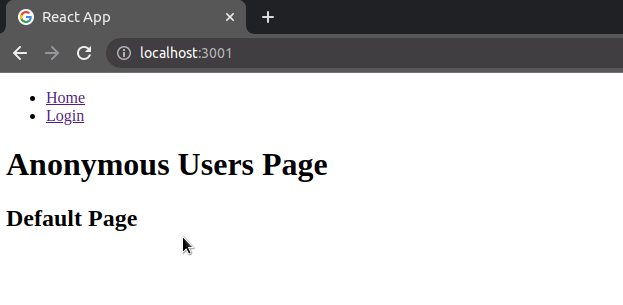
The Outlet component is used in a parent route to render their child route elements.
The AnonymousLayout component is always rendered and when the user goes to the
/login page, the <Login /> component is rendered.
The AnonymousLayout component has to render an Outlet component so that its
child route elements get rendered.
# Conclusion
To resolve the React Router warning "No routes matched location", make sure:
- You aren't trying to access a route for which a
<Route />component with the given path hasn't been set. - You haven't forgotten to specify a wildcard matcher for a subpath.
- You haven't used multiple layouts incorrectly (e.g. anonymous/authenticated).
- You don't have multiple
<Routes />components in the same application.
# Additional Resources
You can learn more about the related topics by checking out the following tutorials:
- React Router: [Component] is not a Route component [Fixed]
- useNavigate() may be used only in the context of a Router component
- Redirect to another Page on Button click in React
- Redirect on form submit using React Router
- How to Redirect to an Internal/External URL in React
- Programmatically update query params in React router
- How to remove query params using React Router
- How to Go back to the previous Page with React Router
- No routes matched location in React Router [Solved]

